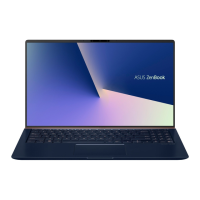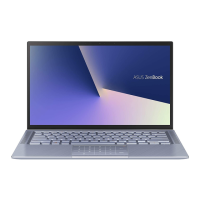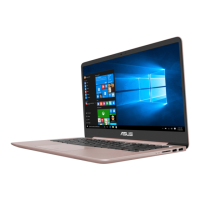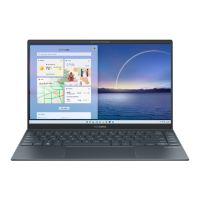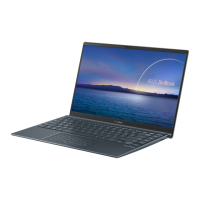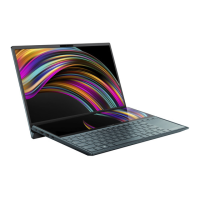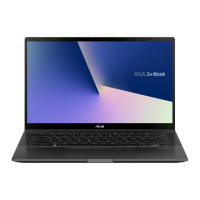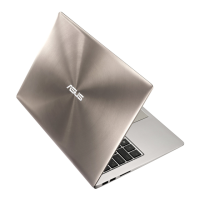Do you have a question about the Asus UX435EG and is the answer not in the manual?
Outlines the manual's chapters: Hardware Setup, Using the PC, Windows 10, POST, Tips, and Appendices.
Explains icons and typography conventions used for key information and references in the manual.
Details safe ambient temperatures, heat management, accessory use, and surface placement.
Provides cleaning instructions and warnings against liquids, dust, and gas leaks.
Advises against municipal disposal and highlights proper recycling for the product and battery.
Illustrates and describes the top view of the Notebook PC for the ScreenPad model.
Illustrates and describes the top view of the Notebook PC for the NumberPad model.
Details the array microphones, built-in camera, and IR camera functionalities.
Describes the high-definition display panel and touch screen capabilities, including gestures.
Explains keyboard functionality, capital lock, and function key lock indicators.
Details touchpad/screenpad usage, power button functions, and power indicator lights.
Describes the display panel and how to toggle between touchpad and NumberPad functions.
Illustrates and describes components visible on the bottom of the Notebook PC.
Explains the function of air vents for cooling and the built-in audio speakers.
Describes the MicroSD card slot, headphone/headset/microphone jack, and USB 3.2 Gen 1 port.
Details the HDMI port for multimedia playback and Thunderbolt 4 port features.
Explains Thunderbolt 4 port compatibility, transfer rates, and power delivery functions.
Describes the power indicator light and the two-color battery charge indicator meanings.
Provides step-by-step instructions for charging the Notebook PC for the first time.
Illustrates how to open the display panel and press the power button to start the Notebook PC.
Explains how to use edge swipes (left/right) on the touch screen panel for navigation.
Describes tap, double-tap, press-and-hold, and pinch-to-zoom/unzoom gestures on the touch screen.
Explains finger slide for scrolling/panning and drag operations for selection and movement.
Details how to move the pointer and perform slide gestures (horizontal, vertical, diagonal) on the touchpad.
Explains one-finger tap/double-tap for selection/launch and drag-and-drop operations.
Describes left-click, right-click, and two-finger tap gestures on the touchpad.
Explains two-finger scrolling (up/down, left/right) and zoom gestures on the touchpad.
Covers drag and drop operations and using a three-finger tap to invoke Cortana.
Explains three-finger swipes for switching apps and showing the desktop.
Describes four-finger tap for Action Center and customizing touchpad settings.
Explains how to toggle, adjust brightness, and use the NumberPad with calculator integration.
Lists and describes HotKeys (F1-F8) for controlling speaker volume, display brightness, touchpad, and display mode.
Explains enabling/disabling function keys, HotKeys, and Windows keys for Start menu and context menus.
Guides through the initial Windows 10 setup process, including region, language, and basic settings.
Explains the Start menu as a gateway to programs, apps, folders, and common activities like shutting down.
Details methods to launch the Start menu and open programs using touch, mouse, or keyboard.
Describes Windows® apps displayed in tiled format on the Start menu and potential sign-in requirements.
Explains how to launch, move, resize, unpin, and pin apps using touch, mouse, or keyboard.
Outlines the manual's chapters: Hardware Setup, Using the PC, Windows 10, POST, Tips, and Appendices.
Explains icons and typography conventions used for key information and references in the manual.
Details safe ambient temperatures, heat management, accessory use, and surface placement.
Provides cleaning instructions and warnings against liquids, dust, and gas leaks.
Advises against municipal disposal and highlights proper recycling for the product and battery.
Illustrates and describes the top view of the Notebook PC for the ScreenPad model.
Illustrates and describes the top view of the Notebook PC for the NumberPad model.
Details the array microphones, built-in camera, and IR camera functionalities.
Describes the high-definition display panel and touch screen capabilities, including gestures.
Explains keyboard functionality, capital lock, and function key lock indicators.
Details touchpad/screenpad usage, power button functions, and power indicator lights.
Describes the display panel and how to toggle between touchpad and NumberPad functions.
Illustrates and describes components visible on the bottom of the Notebook PC.
Explains the function of air vents for cooling and the built-in audio speakers.
Describes the MicroSD card slot, headphone/headset/microphone jack, and USB 3.2 Gen 1 port.
Details the HDMI port for multimedia playback and Thunderbolt 4 port features.
Explains Thunderbolt 4 port compatibility, transfer rates, and power delivery functions.
Describes the power indicator light and the two-color battery charge indicator meanings.
Provides step-by-step instructions for charging the Notebook PC for the first time.
Illustrates how to open the display panel and press the power button to start the Notebook PC.
Explains how to use edge swipes (left/right) on the touch screen panel for navigation.
Describes tap, double-tap, press-and-hold, and pinch-to-zoom/unzoom gestures on the touch screen.
Explains finger slide for scrolling/panning and drag operations for selection and movement.
Details how to move the pointer and perform slide gestures (horizontal, vertical, diagonal) on the touchpad.
Explains one-finger tap/double-tap for selection/launch and drag-and-drop operations.
Describes left-click, right-click, and two-finger tap gestures on the touchpad.
Explains two-finger scrolling (up/down, left/right) and zoom gestures on the touchpad.
Covers drag and drop operations and using a three-finger tap to invoke Cortana.
Explains three-finger swipes for switching apps and showing the desktop.
Describes four-finger tap for Action Center and customizing touchpad settings.
Explains how to toggle, adjust brightness, and use the NumberPad with calculator integration.
Lists and describes HotKeys (F1-F8) for controlling speaker volume, display brightness, touchpad, and display mode.
Explains enabling/disabling function keys, HotKeys, and Windows keys for Start menu and context menus.
Guides through the initial Windows 10 setup process, including region, language, and basic settings.
Explains the Start menu as a gateway to programs, apps, folders, and common activities like shutting down.
Details methods to launch the Start menu and open programs using touch, mouse, or keyboard.
Describes Windows® apps displayed in tiled format on the Start menu and potential sign-in requirements.
Explains how to launch, move, resize, unpin, and pin apps using touch, mouse, or keyboard.
| Processor | Intel Core i7-1165G7 |
|---|---|
| RAM | 16GB LPDDR4x |
| Storage | 1TB PCIe NVMe SSD |
| Refresh Rate | 60Hz |
| Display | 14-inch |
| Display Type | IPS |
| Graphics | NVIDIA GeForce MX450 |
| Operating System | Windows 10 Pro |
| Battery | 63Wh |
| Ports | 1x USB 3.2 Type-A, 2x Thunderbolt 4 |
| Wireless | Wi-Fi 6 (802.11ax), Bluetooth 5.0 |
